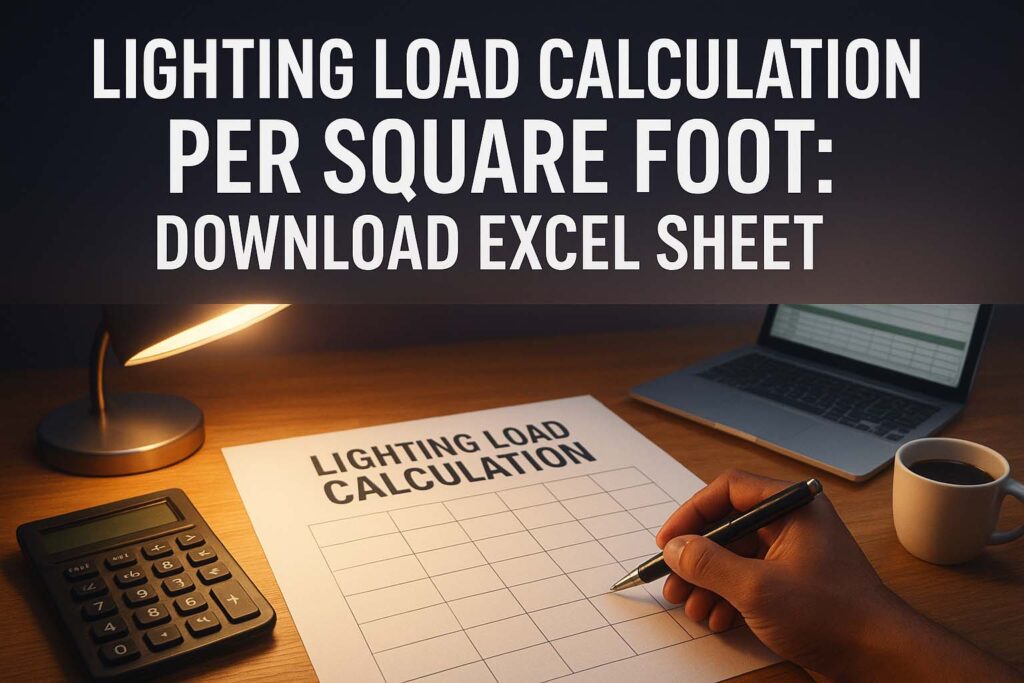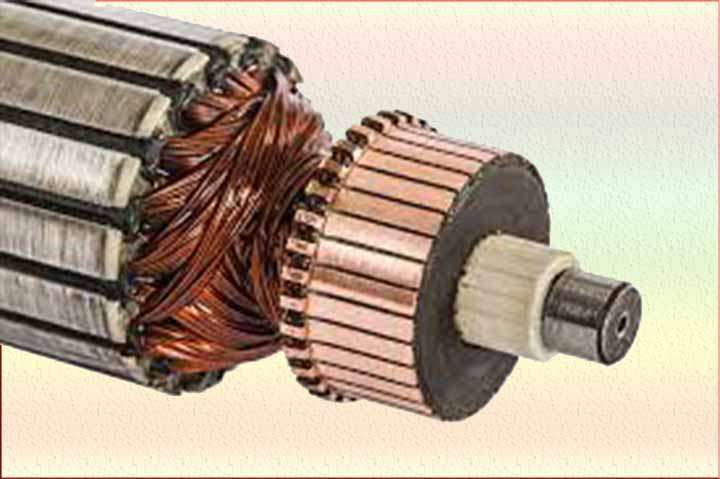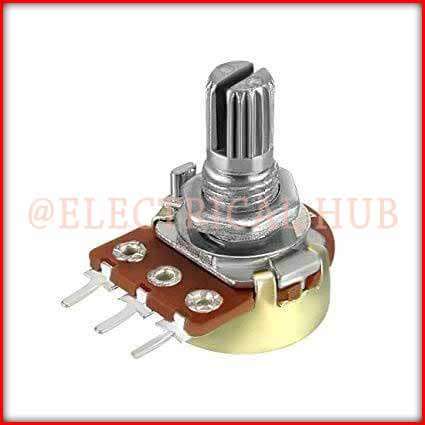Lighting Load Calculation per Square Foot: Download Excel Sheet
Designing an efficient lighting system is one of the most critical aspects of electrical planning for residential, commercial, and industrial buildings. Engineers, contractors, and architects rely on accurate lighting load calculations to determine how much power will be consumed, how circuits should be distributed, and how much energy cost will result over time. Without precise estimation, under or over-sizing circuits may lead to voltage drops, unnecessary energy bills, or even safety hazards. This is where lighting load calculation per square foot plays a crucial role.
Table of Contents
Table of Contents

When we talk about load estimation, we are not just calculating the number of lamps or fixtures, but we are also determining the connected electrical demand against the total floor area. A systematic approach helps ensure proper illumination, compliance with standards, and energy efficiency. To simplify this task, I have also shared a useful Electrical Load Estimation calculator in another post that complements this article. It allows you to easily compute loads, including lighting, and export them in Excel format for project documentation.
Lighting load calculation is not just about numbers. It’s about balancing comfort, safety, and efficiency while meeting international standards like NEC (National Electrical Code) and IEC (International Electrotechnical Commission). Whether you are planning for a new office building, a hospital, or even a warehouse, calculating lighting demand per square foot is the first step toward electrical design accuracy.
Key Takeaways:
- Lighting load calculation per square foot is essential for energy-efficient electrical design.
- Different building types have different watts-per-square-foot requirements as per NEC and IEC guidelines.
- A downloadable Excel sheet can simplify load computation for engineers and designers.
What is Lighting Load Calculation per Square Foot?
Lighting load calculation per square foot is the process of estimating the electrical demand required to provide adequate illumination across a defined floor area. This is generally expressed in watts per square foot (W/ft²). For example, if an office space requires 3 watts per square foot and the area is 1,000 ft², then the total lighting load will be:
Lighting Load = Area × Watts per Square Foot = 1,000 × 3 = 3,000 watts
This calculation allows engineers to plan wiring, circuit breakers, transformers, and even backup power sources based on realistic load demands.
Use our online tool Power Factor Correction Capacitor Calculator
Why is Lighting Load Calculation Important?
Accurate lighting load calculation per square foot provides multiple benefits:
- Ensures compliance with building codes and energy efficiency standards.
- Prevents oversizing or undersizing of electrical infrastructure.
- Helps in predicting electricity bills and energy costs.
- Facilitates planning for renewable systems like solar, where load estimation is critical.
- Improves safety by ensuring the right amount of illumination without overloading circuits.
Standard Lighting Load Values per Square Foot
Lighting load per square foot is not the same for every building type. The NEC and IEC provide reference values that are widely adopted in the industry.
Here is a table showing standard values:
| Building Type | Lighting Load (Watts per Square Foot) |
|---|---|
| Residential Houses | 1.5 – 2 W/ft² |
| Offices | 2 – 3 W/ft² |
| Hospitals | 2 – 3.5 W/ft² |
| Schools/Classrooms | 2.5 – 3 W/ft² |
| Retail Stores | 3 – 4 W/ft² |
| Warehouses | 1 – 1.5 W/ft² |
| Restaurants | 2.5 – 3 W/ft² |
| Hotels | 2 – 3 W/ft² |
These values are approximate and may vary depending on specific code requirements, occupancy, and local standards.
Know more about Circuit Breaker Size Calculator for Appliances
Formula for Lighting Load Calculation per Square Foot
The general formula used in calculations is:
Total Lighting Load (W) = Area (ft²) × Watts per Square Foot
For example:
- Area = 2,000 ft²
- Load per unit area = 2.5 W/ft²
Lighting Load = 2,000 × 2.5 = 5,000 W = 5 kW
This value can then be used to design distribution boards, circuit breakers, and cabling requirements.
Example of Lighting Load Calculation for an Office
Let’s assume we need to calculate the lighting load for a medium-sized office building:
- Total Floor Area = 5,000 ft²
- Recommended Load Density = 2.5 W/ft²
Lighting Load = 5,000 × 2.5 = 12,500 W = 12.5 kW
Now, if the building uses LED fixtures with an efficiency of 100 lumens per watt, the designer can further check if the calculated load meets the required lux levels (illumination levels measured in lumens per square meter).
Know more about lux level standards
Factors Affecting Lighting Load Calculation per Square Foot
Although standards provide general values, many factors can affect the actual load requirements:
- Type of Fixture: LED lights consume less power than fluorescent or incandescent lights.
- Lux Requirements: Higher lux requirements (like in hospitals or labs) need more watts per square foot.
- Occupancy Hours: Buildings that operate 24/7 need higher reliability in load design.
- Daylighting: Natural light availability can reduce artificial lighting demand.
- Interior Design: Wall colors, ceiling height, and reflectivity impact illumination levels.
Downloadable Excel Sheet for Lighting Load Calculation
Manual calculations can be time-consuming, especially for large projects. That’s why an Excel sheet is often used in practice. An Excel-based calculator allows:
- Input of area in square feet.
- Selection of watts per square foot based on building type.
- Automatic calculation of total lighting load in watts and kilowatts.
- Exportable results for project documentation.
This not only saves time but also reduces human error. You can combine this with my Electrical Load Estimation calculator to cover all types of loads including lighting, HVAC, and sockets.
Use our online tool Watt to Amp Calculator (Single & Three-Phase)
Lighting Load per Square Foot and Energy Efficiency
In today’s world, reducing energy costs is a top priority. By adopting LED technology and advanced lighting control systems like dimmers and motion sensors, the watts per square foot can be significantly reduced. For instance, a retail store designed at 3.5 W/ft² with fluorescent lights may only require 2 W/ft² when using LEDs.
This means the Excel sheet should also allow for custom entries so engineers can modify watts per square foot based on chosen fixtures.
Practical Tips for Engineers and Contractors
- Always cross-check calculated loads with lux level requirements to ensure compliance.
- Use the NEC and IEC guidelines as a baseline but adjust based on fixture efficiency.
- Maintain a margin of at least 10% for future expansions or changes in occupancy.
- Document all calculations in Excel for approvals, audits, and energy certification.
- Integrate load calculations with other systems like HVAC for overall building demand estimation.
Use our online tool House Wiring Cable Size Calculator
Conclusion
Lighting load calculation per square foot is an essential step in electrical system design. By applying standard watts-per-square-foot values, engineers can ensure both safety and efficiency. However, it is equally important to adapt these values based on fixture technology, lux requirements, and occupancy conditions. To make this process simpler, the downloadable Excel sheet can act as a reliable tool for engineers and contractors.
For a complete overview that includes lighting, HVAC, and socket loads, you can also explore my Electrical Load Estimation calculator which complements this guide and helps prepare accurate load schedules. By mastering lighting load calculation per square foot, you can achieve compliance, efficiency, and long-term energy savings in your projects.
Use our online tool Amps to Wire Size Calculator
Follow Us on Social:
Subscribe our Newsletter on Electrical Insights to get the latest updates in Electrical Engineering.
#LightingLoadCalculation, #ElectricalLoadEstimation, #LoadCalculation, #LightingDesign, #ElectricalEngineering, #PowerLoad, #LoadCalculationExcel, #LightingEfficiency, #BuildingServices, #ElectricalSafety, #EnergyAudit, #LoadCalculator, #ElectricalDesign, #CommercialLighting, #LightingCalculation






